Abstract
The paper presents the results of the development of a multi-layer protective product, which is a transformable fire barrier, installed in buildings and structures to limit the spread of flame, heat flow and smoke. Based on the results of the simulation of eight samples of fire curtains, three promising samples of different compositions were selected, demonstrating a fire resistance limit on the loss of thermal insulating capacity (I) of 30 min. During the small-scale tests, it was found that the multilayer fabric of the following composition was promising: heat-treated silica fabric, aluminum foil, mineral fiber heat insulation material, stitched by needle-punching with silica thread, fabric reinforced with fiberglass mesh and stitched through with basalt thread, with seams treated with a fire-resistant elastic sealant. According to the results of a standard large-scale experimental study, a fire curtain with a loss of integrity not less than 60 min, and a loss of thermal insulating ability not less than 15 min were obtained. The results of the study assess the impact of the scale factor on the fire resistance limit of fire curtains in a fire.
1. Introduction
Fire in a building or structure usually occurs in an enclosed environment, which allows for the rapid spread of flames, heat flow and smoke throughout the structure, thereby blocking escape routes [1]. Their distribution is influenced by the space-planning and design solutions of the buildings and structures, the use of supply smoke ventilation and the means of mechanical and natural smoke ventilation [2]. Transformable fire barriers in the form of curtains are most widely used to protect openings in fire compartments and to organize fire compartments in the spaces of buildings of any functional purpose [3]. Fire curtains affect a fire in two ways: they create a barrier to prevent the spread of flames, heat flow, and smoke; and they prevent the entry of oxygen into the room with the fire seat, which leads to the gradual attenuation of the fire inside that room.
A characteristic design feature of fire curtains is the execution of the enclosing part (working canvas) in the form of an elastic flat element of heat-resistant materials with heat-insulating capacity [4]. Transformable fire curtains are designed to operate in heated rooms in a temperature range from +5 °C to +40 °C in an explosion-proof environment. The main differences between transformable fire curtains and fire gates are the use of lighter materials, the possibility for overlapping large openings and the potential to isolate individual areas [5]. These characteristics allow for the widespread use of transformable fire curtains directly in retail halls, showrooms, offices and public buildings with a large number of people (Figure 1).
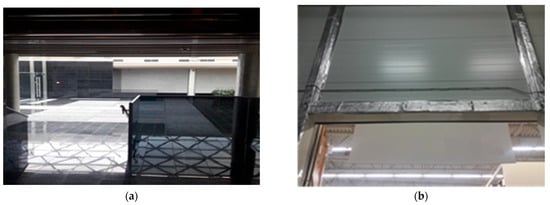
Figure 1.
Fire curtain in: (a) Public space of an apartment complex; (b) Shopping mall.
Fire-resistant curtains protect from the spread of flames, heat flow and smoke both through a small window opening or throughout a large hangar with equipment, an atrium with retail outlets or a warehouse (Figure 2). Fire curtains are widely used in the design of underground structures, including tunnels. Gao and co. [6] conducted full-scale tests in a tunnel 140 m long, 5.0 m to 5.9 m high and 5.8 m to 10.8 m wide. A 200 mm wide air curtain covering the entire side of the tunnel was installed under the tunnel ceiling. The experiment showed that the air curtain at exit velocities of 12 m/s and 16 m/s could stop the spread of smoke generated by a 1 MW and 2 MW fire, respectively. Yu and co. [7] conducted small-scale experiments to study the effect of air curtain sealing for smoke retention in the tunnel. The simulations provided additional information about the distribution of air flow and temperature fields. Fire curtains protect both vertical and horizontal openings [8]. When using a transformable fire curtain, it is possible to avoid the spread of fire and toxic products of combustion both in the stairwell and in the elevator shaft.
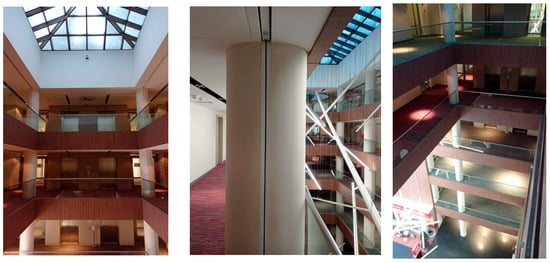
Figure 2.
Fire curtain in the atrium of a business center.
The curtain canvas is a multilayer product, most often closed on both sides by a specialized fabric, the main criterion of which is the ability to operate at temperatures up to 1000 °C [9]. Such fabrics include: silica, quartz, basalt and glass. Further, the fabric of the first layer is treated with various compositions which include the addition of flame retardants, while the inside of the curtain fabric contains various components. When silica materials are calcined at extreme temperatures, the strength properties of the fibers are lost; thus, the breaking load is reduced. This increases the probability of the curtain breaking from the roll and the appearance of cracks and gaps in the fabric (loss of integrity (E)).
According to [10], curtains are classified according to their fire resistance limit states (EI) (E—limit state for loss of integrity, I—limit state for loss of thermal insulating capacity), namely EI60, EI120, E60, E120, E180—usually with the use of irrigation; EI15, EI 30 and E60—without irrigation. Fire curtains are standardized according to the parameters E and I, and sometimes (S) (smoke tightness). This depends on the design requirements for the facility and test methods.
According to [11], if fire curtains are operated in the open position, they must be equipped with devices that can ensure that they close automatically in case of fire, and such fire structures must maintain operability in fire conditions for the time necessary to perform their functions and evacuate people to a safe area. These curtains are equipped with an electronic automatic system that connects to the central fire alarm, smoke detectors and other warning and protection systems [12].
The most common curtains are EI15, EI30, E60 and EI60 [13]. The specific choice of curtain depends on the type of product, the standardized fire resistance limits on loss of structural integrity and the ability to prevent the passage of intense heat flow from the fire. The typical arrangement of a curtain and a transformable barrier is shown in Figure 3.
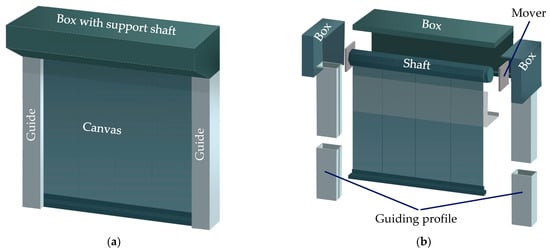
Figure 3.
Typical arrangement of a transformable fire curtain: (a) general view; (b) in detail.
As a heat-insulating material for fire curtains, silica fabrics; fiberglass thin blankets [14]; various heat-insulating materials, such as aerogel—a material based on silicon dioxide with extremely low thermal conductivity [15,16]; materials based on super-thin basalt fiber and mineral wool of different density [17,18]; as well as modern flexible polymer-composite materials [19] are used. Carbon fiber is also used, but not so widely, due to its high cost. Hydrocarbon fibers have extremely high thermal resistance; when exposed to heat up to 1600–2000 °C in the absence of oxygen, the mechanical parameters of the fibers are the same. This predetermines the possibility for application of hydrocarbon fibers as heat shields and heat insulating material in high-temperature technology. On the basis of hydrocarbon fibers, carbon composites are made, which are characterized by high ablative resistance [20,21].
The closest technical solutions for transformable fire curtains are roll-up doors, fire curtains with a flexible fabric or fire barriers with a porous flexible fabric. The first roll-up fire doors were created in the 1930s. Patent US1369518A [22], published in 1921, describes a “Fire-door” roll-up fire door system, which, in case of fire, is actuated by a spring mechanism, and water spray is used to protect the structure.
Eremina and co. [23] considered a fire barrier with two layers of insulating material based on foil-coated basalt fiber (16 mm) and liquid glass composition in the form of glue to prevent the spread of flames, heat flow and smoke, and to ensure the safe evacuation of people. According to the results of the study, it was found that with a total layer thickness of 30 mm and a canvas size of 2000 × 2000 mm, the time to reach the limit state of thermal insulating ability is 31 min and the time to loss of integrity is 60 min. According to the patent of Sechina and co. [24], when silica materials are calcined in conditions of extreme temperatures (fire), they lose the strength properties of the fibers and the breaking load decreases. In this regard, the probability of breakage of the curtain from the shaft (loss of integrity (E)) increases. Thus, the patent proposes a multilayer canvas transformable fire barrier, according to the results of the experimental study in which the fire-resistance limit of E60 was obtained.
A fire curtain must comply with the required parameters of fire resistance, have a low density (low weight) and a small thickness in operation to be able to roll up and roll out. In the process of developing a fireproof curtain, three methods are used for its operation in case of fire: (1) formation of a new heat-insulating layer in the “pockets” of the curtain with a thickness of 50–80 mm; (2) formation of a new heat-insulating layer inside the curtain with a thickness of 50–80 mm; (3) use of endothermic processes when heating a large enough layer of mineral wool, aerogel, basalt superfine fiber and other non-bulging materials (Figure 4). In the third case, it is possible to use the presence of crystallization water in porous-fiber materials; however, slabs or coatings on mineral binders are characterized by considerable rigidity and brittleness, which makes it difficult to use them for fire curtains. In this study, layers of fabric were placed according to the second and third methods of fire curtain operation in case of fire.
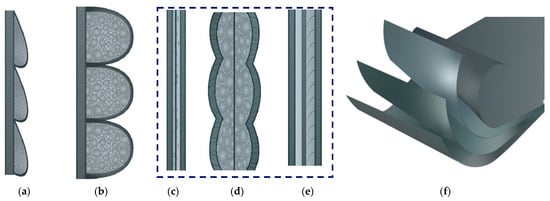
Figure 4.
The formation of a thermal insulating layer in: (a,b) special pockets; (c,d) inside the curtain; (e) the use of non-permeable thermal insulating materials in the curtain; (f) general view of the layered package forming the curtain fabric.
Maintaining the integrity of the curtain fabric (parameter of fire resistance limit E) is the first priority, because the formation of cracks and breaks will not allow the further use of the structure of the fire curtain as a barrier to prevent the spread of flames, heat flow and smoke to adjacent rooms.
The aim of the paper is to develop a perspective fire protection canvas with a fire-resistance limit of at least E60 (on loss of integrity) and at least I15 (on loss of thermal insulating capacity), taking into account the lack of water sprinkling.
To achieve this goal, the following research problems were solved: the materials for the fabric of the fire curtain were determined; eight prototypes of curtains, which are based on the most widely used cladding and insulating materials were created; the values of heat insulating parameter (I) on the unheated sides of the transformable fire barrier were obtained by simulation method; small- and large-scale tests of fire curtain samples to determine the fire resistance of the transformable fire curtain were carried out.
The scientific novelty of the research consists of the establishment of regularities of heat transfer processes in layers of packages of transformed fire barriers with different combinations of used materials by simulation method; the determination of the fire resistance of transformed fire barriers on the basis of perspective materials, taking into account the absence of water irrigation.
2. Materials and Methods
Two methods are considered in the work: simulation of the heating of the fire curtain structure and experimental studies based on the selected perspective composition.
Before the simulation, an analysis of the effect of fire canvas parameters on heating in the software package (SP) STATISTICA, which implements the functions of analysis, management and visualization of data involving statistical methods, was carried out [25]. Based on the results of the simulation planning and experiment, the response surfaces of the system were obtained (Figure 5). The labels indicating the color intensities demonstrate that the maximum density is achieved when the parameters change in the central ellipse. All values of the independent variables falling within the central ellipse lead to the best performance of the curtain fabric (dark red shows the best values of the considered structures in terms of temperature on the unheated side of the canvas).
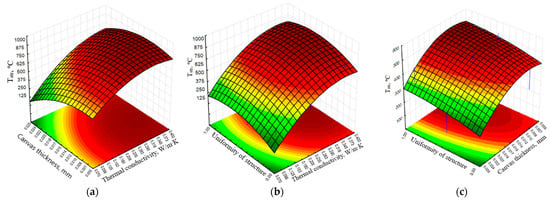
Figure 5.
Influence of fire fiber parameters on structure heating: (a) thickness and thermal conductivity; (b) uniformity of structure and thermal conductivity; (c) uniformity of construction and thickness.
From the planning results, it was determined that the prototypes with higher thickness and materials of lower thermal conductivity have a better characteristic of the temperature value on the unheated side. In terms of homogeneity of construction, prototypes with fewer layers of different materials are more efficient. The greatest contribution influencing the temperature value on the unheated side of the sample is thermal conductivity (56%), the second most significant is the cross-section of the canvas (thickness) of the transformable fire curtain (32%). The cost of construction is not a statistically significant effect (13%).
2.1. Materials
The main element of a fire curtain is a canvas made of thin metal, silica or glass fabric. The silica fabric is heat-treated to minimize its thermal shrinkage in case of fire and has a heat resistance up to 1100 °C [26]. Figure 6 shows the material options for the curtain fabric according to the criteria of the maximum long-term operating temperature and the value of the breaking load.
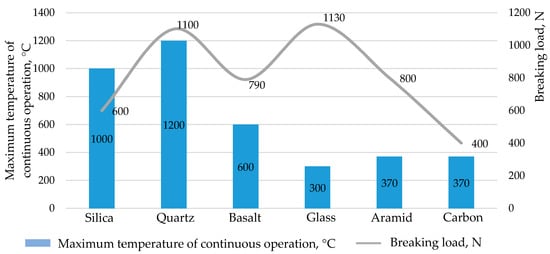
Figure 6.
Material variations for the curtain fabric.
The main criterion for the fabric is non-combustibility and preservation of the integrity (no cracks or pores, as well as the absence of their formation during the fire action).
The most appropriate material for the fabric of fire curtains is silica fiber, in terms of the optimal limit temperature of long-term operation (1000 °C), corresponding to the temperature of heating under the standard temperature regime (Figure 6). On the basis of silica fibers produced several types of silica fabrics, listed in Table 1.

Table 1.
Types of silica fabrics.
Silica heat-shrinkable fabrics are the most preferred as reinforcing material. Thanks to heat shrinkage, the risk of losing the integrity of the fabric due to high temperature loads during the test or in case of fire at the site is reduced [27]. Silica heat-shrinkable fabric KT-E-115-TO was adopted for the experimental studies. For the justification of this choice, a standard large-scale experiment, given in Section 3.3, was conducted.
2.2. Determination of the Compositions of the Fabric Layers of a Fire Curtain
Based on a patent search and analysis of scientific literature [28,29,30,31], eight samples were constructed, additionally containing in the first and last layer a silica heat-shrinkable fabric KT-E-115-TO (Table 2), This means that Sample No. 1 was composed of heat-shrinkable fabric + intumescent composition + heat-shrinkable fabric. Layers of the fabric were placed according to the second and third methods of operation of the fire curtain in case of fire (Figure 4). The characteristics of some materials are presented in Table 3.

Table 2.
Examined samples of fireproof canvas.

Table 3.
Characteristics of materials in fire curtains.
For Sample No. 1, the fabric was smeared with a water-based intumescent compound containing the well-known classic triad: ammonium polyphosphate, melamine, and pentaerythritol. Sample No. 2 was strengthened with titanium whitewash and aluminum hydroxide [21]. In Sample No. 3, the fabric was smeared with a heat-resistant elastic silicone sealant, and then the bloating paint was also applied (as in Sample No. 1). Silicone one-component sealant has good adhesion to most surfaces and is used for sealing joints exposed to high temperatures, in heating systems during the repair of cars and engines [33]. The heat resistance of the cured composition is from −65 to +260 °C, briefly up to +315 °C. Sample No. 6 comprises a fiberglass (whose characteristics are close to basalt, but quite cheaper) and a mesh with an intumescent composition and a foil material [34]. Sample No. 8 adopted one layer of Alison Aerogel GR10 [32] and one layer of Ceraterm Blanket [35], used as a thermal insulation layer in furnace units with a classification temperature of 1260 °C.
2.3. Simulation of Fire Curtains Canvas
The QuickField software package or its Russian counterpart ELCUT was used as a modeling tool to specify the thermal impact on the ribs or individual model vertices using the finite element method [36]. SP ELCUT has been repeatedly used to solve thermophysical problems to verify by comparing the results obtained with experimental data. For example, Gravit and co. [37] conducted experimental studies and simulation in SP ELCUT of steel structures with three different types of plaster. Simulation of the heating of steel structures showed good correlation with the experimental results and allowed to predict the consumption of plastering compound for a sample steel column. Gravit and co. [17] conducted experimental studies on the loss of integrity (E) and thermal insulating capacity (I) of steel bulkheads and decks with mineral wool under standard and hydrocarbon fire regimes. Simulation of bulkhead and deck heating showed excellent correlation with the experimental results and allowed to predict the consumption of mineral slabs and endothermic mats for steel bulkheads.
SP ELCUT has been repeatedly used to simulate the heating of oversized structures. For example, Gravit and co. [38] considered the effect of fire exposure on modern windows and facade glazing elements; it is shown that ELCUT allows for prediction of the behavior of building structures at elevated temperatures and to display temperature distributions and stress fields. Gravit and co. [39] presented the results of large-scale fire tests of lightweight thin-walled steel structures for fire protection efficiency in SP ELCUT. As a result, temperature–time curves of steel structures in the standard fire regime were obtained, which showed good correlation between the simulation and experimental studies. Gravit and co. [40] conducted experimental studies of large-sized and small-sized samples of tempered fire-resistant glass as part of double-glazed units in steel and aluminum frames under the influence of a standard fire regime. According to the results of the experimental study, it is revealed that the fire resistance limit by loss of integrity of small-size samples is higher than the fire resistance limit of large-size samples by 29%.
When modeling the heating problem in the QuickField, the heat conduction equation is used, which is determined by dependence (1) [41]:
where is temperature, °C; t is the time, s; λ are the components of the thermal conductivity tensor, W/(m∙K); q is a specific power of heat release, W/m3; c is a specific heat capacity, J/(kg∙K); ρ is a density, kg/m3.
Boundary conditions, described by temperature, heat flux, convection and radiation (boundary conditions of the third kind), are set on the external and internal boundaries of the design model. The value is specified as a linear function of the coordinates. The heat flow is described by relations (2) and (3) [36]:
where is the normal component of the heat flux density vector, indices “+” and “−” mean “to the left of the boundary” and “to the right of the boundary”, respectively, W/m2; is a surface power of the source for the inner boundary, for the outer—the known value of the heat flux through the boundary, W/m2.
Convective heat transfer is determined according to expression (4) [42]:
where is the heat transfer coefficient, W/(K∙m2); is an ambient temperature, K.
The radiation condition is set on the outer boundary of the model, the radiative heat transfer is determined by Equation (5) [36]:
where is the Stefan–Boltzmann constant, W/(m2 + K4); β is the absorption coefficient of the surface; is the temperature of the absorbing medium, K.
Simulation was performed for fire curtain canvas under standard fire conditions, according to ISO 834-1 [43], characterized by dependence (6):
where is the temperature in the furnace corresponding to the time t, °C; is the temperature in the furnace before the start of thermal exposure t, °C; t is the time calculated from the start of testing, min.
The initial characteristics of the intumescent composition, aerogel, foiled basalt fiber and other components were taken from the program handbook and scientific works [21,44,45] (Table 4). It is assumed that the density value does not change during the heating process.

Table 4.
Thermal characteristics of materials.
Boundary conditions are presented in Table 5.

Table 5.
Boundary conditions defined in the SP QuickField.
Simulation of heating of eight prototype canvases of transformable fire curtains was performed to predict the values of temperature of the canvas on the unheated side and to determine the optimal compositions of fire curtains. Examples of calculation schemes for Sample No. 6 and Sample No. 7 are shown in Figure 7.

Figure 7.
Calculation schemes: (a) Sample No. 6; (b) Sample No. 7.
2.4. Conducting an Experimental Study
Fire curtains are tested according to two standards: test methods for the fire resistance of gates and doors according to [10] and smoke screens according to [46].
Reaching the limit state for loss of integrity (E) occurs as a result of the formation of through cracks or holes in the structure, through which the products of combustion or flame penetrate, namely:
- the appearance of a steady flame on the unheated surface of the test sample for 10 s or more;
- ignition or smoldering with glow of the cotton swab as a result of exposure to fire or hot gases, within 10 s after bringing it to the sample;
- formation of through holes (slots) in the construction of the test sample with the dimensions that allow a 6 mm diameter stylus to penetrate and move along the hole (slot) at a distance of at least 150 mm or a 25 mm diameter stylus to penetrate through holes unhindered;
- falling out of the sample canvas from the box or the box itself from the enclosing structure.
Reaching the limit state for the loss of thermal insulating capacity (I) occurs because of the temperature increase on the unheated surface of samples, in average more than 140 °C in comparison with the surface temperature of the test sample (taking into account the start temperature of the test) before the test for smoke and gas permeability [10].
A small-size fireclay brick furnace of 790 × 790 × 965 mm, in which diesel fuel (two burners) regulated the temperature in the furnace according to the standard temperature regime according to ISO 834-1 [43] (Figure 8), was used for conducting small-scale tests on the samples. The dimensions of the investigated fire transformable barriers were 1000 × 1000 mm.
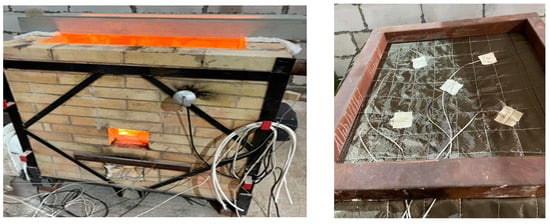
Figure 8.
Furnace for small-scale testing.
For large-scale (standard) testing, a sample of a fire-resistant canvas was installed in a fragment of the fencing concrete structure with a thickness of 250 mm. Thermocouples of TPK011-0.5/5 type in quantity of 5 pieces were placed on the fabric surface (Figure 9). Furnace temperature conditions were controlled by two thermocouples TP-0395-06XA (K), the length of immersion part was 500 mm. The dimensions of the investigated fire transformable barriers were 3000 × 3000 mm.
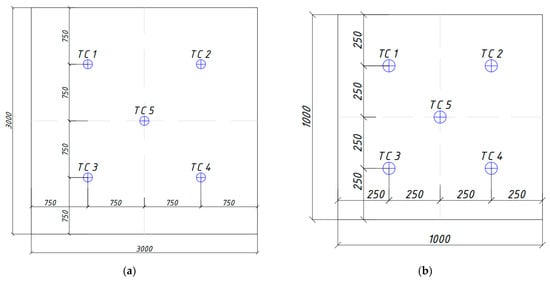
Figure 9.
Location of thermocouples on: (a) large-sized sample; (b) small-sized sample.
The temperature in the furnace during the tests was maintained in accordance with the requirements [47]. The duration of the experimental study was 60 min.
3. Results and Discussion
3.1. Simulation Results and Obtaining the Most Preferred Compositions of Fire Curtain Canvas
As a result of the simulation, visualizations of the heating of the fire curtain structures were obtained. As an example, Figure 10 and Figure 11 show the heating results for Sample No. 6 and Sample No. 7.
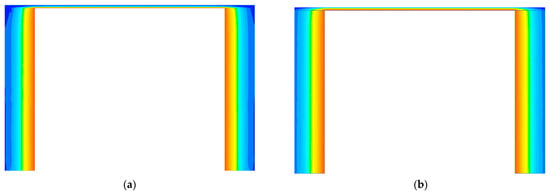
Figure 10.
Visualization of heating: (a) Sample No. 6; (b) Sample No. 7.

Figure 11.
Temperature scale for standard fire mode.
Calculated temperature–time dependences at the thermocouple location on the unheated surface of the transformable fire curtains were obtained (Figure 12).
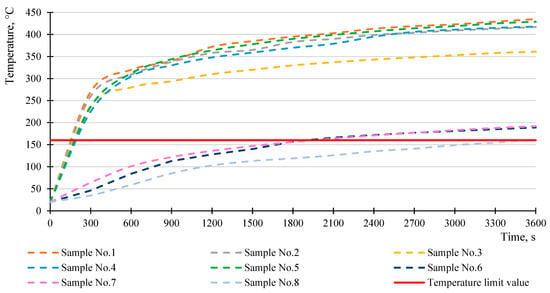
Figure 12.
Calculated temperature curves of samples at standard temperature conditions.
As shown in Figure 12, the graphs for Samples No. 1, No. 2, No. 4 and No. 5, containing intumescent compositions in the base, grow at a higher rate in the first minutes of fire exposure, while Sample No. 3, additionally containing heat-resistant silicone, shows better temperature values on the unheated surface of the transformed canvas.
Models with intumescent compositions, despite negative results compared to other samples, remain perspective for further study because of their ability to expand and form a foamcoke with low thermal conductivity and economic potential. On average, a 40% reduction in temperature on the unheated side can be achieved by increasing the thickness of the prototype. However, in real operation, transformable fire curtains with a thickness of 20–50 mm do not functionally differ from roller shutters, which raises the question of the feasibility of such an engineering solution.
As can be seen in Figure 12, Samples No. 6–No. 8 showed preferable results for their fabrication and fire tests. Sample No. 8, showing the lowest temperature values, has a fire curtain thickness of 0.024 m. Due to the greater manufacturability and greater rollability of the fire-resistant fabric in the manufacture of the product, it is advisable to use fire-resistant curtains with a thickness of 5 to 12 mm. Thus, Sample No. 8 is less technological due to its excessive coating thickness, but it was decided in this work to conduct an experimental research of determining the fire-resistance limits of this curtain.
Samples No. 6–No. 8. Were selected as the preferred prototypes for the experimental study.
3.2. Results of Small-Scale Tests
According to the results of the simulations of heating of fire transformable barriers, Samples No. 6–No. 8 were selected for small-scale tests.
For Sample No. 6, the small-scale fire test was terminated at 61 min by order of the technical customer. The limit state for the loss of thermal insulating capacity (increase in temperature on the unheated surface of the structure by more than 140 °C on average) was reached at the 33rd minute of the experimental study. According to the test results, there was no smoke and flame penetration on the unheated side; the integrity of the sample was preserved. It was found that Sample No. 6, consisting of fiberglass, mesh with intumescent composition and foil material (total thickness of 12 mm), has a fire resistance limit under the standard temperature conditions of E60 (loss of integrity) and I30 (loss of thermal insulating capacity).
Throughout the experimental study of Sample No. 6, temperatures were additionally determined using a thermogram (Figure 13).
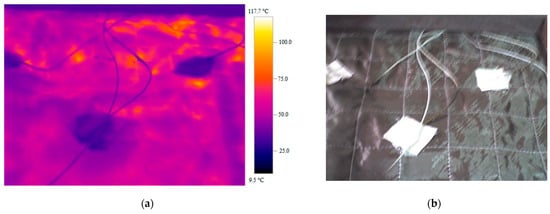
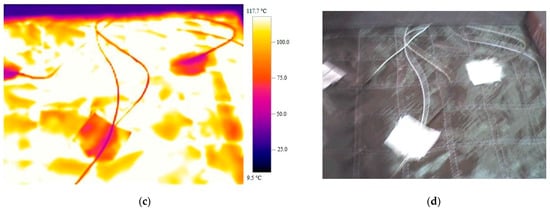
Figure 13.
Thermograms and visual representation of Sample No. 6 during the fire test: (a,b) in the first minute of fire exposure; (c,d) in the 20th minute of fire exposure.
For Sample No. 7, the small-scale fire test was terminated at 29 min due to achieving loss of sample integrity at 28 min of fire exposure. According to the results of the test, breakdowns were observed in the fire canvas, as was the exit of soot on the unheated surface. Thus, the integrity of Sample No. 7 was compromised (Figure 14). It was found that Sample No. 7, consisting of a layer of aerogel with a thickness of 12 mm, has a fire resistance limit under the standard temperature conditions of E15 (loss of integrity) and I15 (loss of thermal insulating capacity).

Figure 14.
Occurrence of breakdowns on Sample No. 7 in a small-scale test under standard temperature conditions.
For Sample No. 8, the small-scale fire test was terminated at 60 min by order of the technical customer. The limit state for loss of thermal insulating capacity (increase in temperature on the unheated surface of the structure by more than 140 °C on average) was reached at the 45th minute of the experimental study. According to the test results, there was no smoke and flame penetration on the unheated side; the integrity of the sample was preserved. It was found that Sample No. 8, consisting of a layer of aerogel and a layer of ceramic canvas (total thickness of 24 mm), has a fire resistance limit under the standard temperature conditions of E60 (loss of integrity) and I45 (loss of thermal insulating capacity). The temperature distribution in the form of a thermogram of Sample No. 8 is shown in Figure 15.
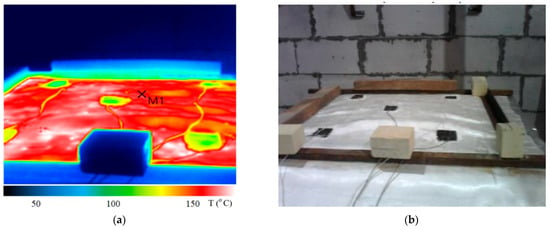
Figure 15.
Sample No. 8: (a) thermogram; (b) visual representation at the 40th minute of the experimental study.
The results of temperature distribution on the unheated side of the fire-resistant canvases of Samples No. 6–No. 8 are shown in Figure 16 (the average temperature values of the thermocouples installed on the samples are presented). The different location of the thermocouples across the section of the samples is shown in Figure 9. According to the results of simulation, excellent correlation of the results was obtained (discrepancy of the values is not more than 5–10%).
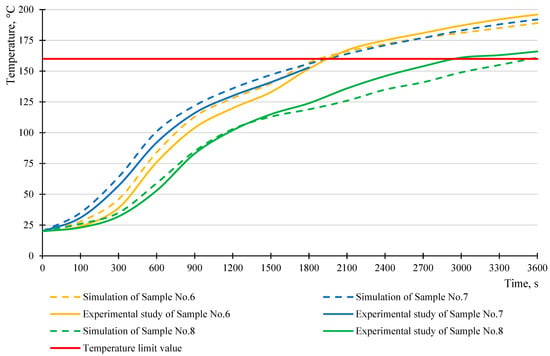
Figure 16.
Experimental and calculated temperature curves of Samples No. 6–No. 8 under standard temperature conditions.
According to Figure 16, it is observed that in a small-scale test, Sample No. 6, which has a thickness of 12 mm, shows a fire resistance limit for loss of thermal insulating capacity (I) of 30 min and for loss of integrity (E) of 60 min, while Sample No. 8, which has a thickness of 24 mm, reaches the thermal insulating capacity limit at the 45th minute of the experimental study and has a fire resistance limit for loss of thermal insulating capacity of I45 and for loss of integrity of E60. Sample No. 7, consisting of a single layer of aerogel with a thickness of 12 mm, loses strength when exposed to standard temperature conditions on the canvas at the 28th minute of the test.
The experimental study revealed that Sample No. 6 is the preferred sample due to its better elasticity and ability to roll up and unroll during operation. Thus, Sample No. 6 was chosen for a large-scale (standard) study.
3.3. Results of Large-Scale (Standard) Test
To justify the selected type of stitching fabric that protects the fire-resistant fabric from above and below, large-scale standard tests of silica heat-shrinkable fabric KT-E-115-TO for loss of integrity (E) were conducted. The experimental study was terminated at the 65th minute upon reaching the limit state for loss of integrity, namely the formation of cracks in the heat-shrink fabric canvas due to high tension (Figure 17). As the experiment showed, the tension reserve of the fabric was insufficient. It is recommended to make the tension of the sample looser (10–15%).
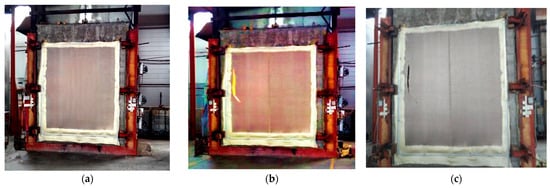
Figure 17.
Experimental study of a heat-shrunk fabric canvas: (a) before the start of the test; (b) at 65 min of fire exposure; (c) after the end of the experiment.
According to the results of simulation and conducting a small-scale experimental study, Sample No. 6 was selected for a standard test in a vertical furnace with dimensions of 3.0 × 3.0 m. The stages of creating a prototype of the transformable fire curtain are shown in Figure 18.
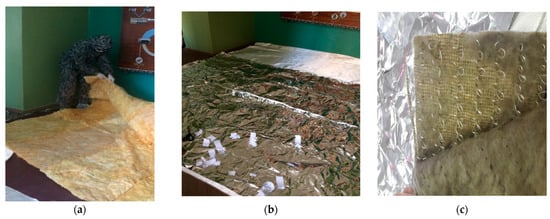
Figure 18.
Manufacturing of Sample No. 6: (a) installation of a layer of nonwoven thermal insulating material; (b) installation of foil material; (c) installation of intumescent mesh.
For Sample No. 6, the large-scale fire test was terminated at 60 min by order of the technical customer. The limit state for the loss of thermal insulating capacity (increase in temperature on the unheated surface of the structure by more than 140 °C on average) was reached at the 15th minute of the experimental study. According to the results of the test, at 3 min, smoke was recorded at the seams of the cloth; the integrity of the sample was preserved (Figure 19). It was found that Sample No. 6, with overall dimensions 3.0 × 3.0 m, consisting of fiberglass, mesh with intumescent composition and foil material (total thickness of 12 mm), has a fire resistance limit under the standard temperature conditions of E60 (loss of integrity) and I15 (loss of thermal insulating capacity).
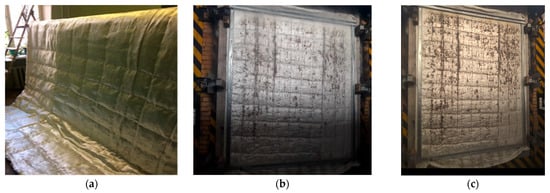
Figure 19.
Sample No. 6 at the time interval: (a) before the start of the test; (b) at the 10th minute of fire exposure; (c) at the 60th minute of fire exposure.
The results of temperature distribution on the unheated side of the curtain are shown in Figure 20 (the average temperature values of the thermocouples installed on the samples are shown). The different location of the thermocouples across the section of the samples is shown in Figure 9.
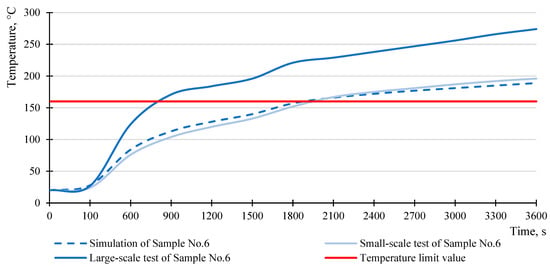
Figure 20.
Experimental and calculated temperature curves of Sample No. 6 under standard temperature conditions.
3.4. Discussion
When simulating the considered samples of fire barrier (Sample No. 1–Sample No.8), three perspective samples were chosen for small-scale research: Sample No. 6, containing fiberglass, mesh with intumescent composition, foil material and heat-shrinkable fabric on the edges; Sample No. 7, consisting of one layer of aerogel and heat-shrinkable fabric on the edges; and Sample No. 8, consisting of one layer of aerogel, one layer of ceramic canvas and heat-shrinkable fabric on the edges. These samples were selected based on the temperature dependencies on the unheated sides of the samples, obtained by simulation, and demonstrating the expected fire resistance limits of E60 (loss of integrity) and I30 (loss of thermal insulating capacity).
The small-scale tests for Samples No. 6–No. 8 showed good correlation with the temperature curves obtained by simulation and confirmed the fire resistance limit E60 and I30 for Sample No. 6 and the fire resistance limit E60 and I45 for Sample No. 8. The small-scale test for Sample No. 8, which had a thicker fabric, confirmed the assumption that the fire resistance limit of thermal insulating capacity increases with the thickness of the fire curtain. Sample No. 7, which consisted of one layer of aerogel with a thickness of 12 mm, lost its integrity (parameter E) at the 28th minute of the fire test.
A small-scale test revealed that when designing a large-size sample, preference should be given to a more flexible sample to improve the ability to roll up and down during operation.
As can be seen from Figure 20, the temperature curve for a large-scale test grows at a higher rate than the temperature curve for a small-scale test of the same fire curtain sample, while simulating the heating from the temperature distribution allows for the prediction of the behavior of a small-scale sample. According to the results of a large-scale study, a fire-resistant canvas of sample No. 6 with fire resistance limit E60 and I15 was obtained; that is, the large-scale sample did not reach the required fire resistance limit on the loss of thermal insulating capacity. This result can be explained by the scale factor of the design, which is a combination of various factors: stronger tension of the transformed canvas, horizontal (in a small-scale test) or vertical arrangement of the canvas (in a standard large-scale test) relative to fire exposure in a fire test, higher thermal insulating capacity between the piercing cells. Foil material rupture in the dimensioned canvas and irregular swelling of the mesh relative to the large piercing cells in the canvas are also likely to occur.
4. Conclusions
The creation of means of protection for the structural elements of buildings from fire hazards requires the solution of several problems; namely, the creation of non-combustible, heat-resistant products and structures with high strength properties that meet the requirements of fire safety, and the development of coatings and engineering solutions that can help the structures achieve the necessary fire resistance limit.
The task set in the study is solved by the multilayer fabric, which contains a heat-treated silica fabric, aluminum foil, mineral fiber heat insulation material, stitched by needle-punching with silica thread, fabric reinforced with fiberglass mesh and stitched through with basalt thread, with seams treated with fire-resistant elastic sealant.
As a result of the standard large-scale experimental study, the loss of integrity of the fire curtain sample occurred at 65 min from the start of the test, and the loss of insulating capacity of the sample occurred at 15 min from the start of the test (sample No. 6 of the transformable fire barrier was assigned a fire resistance rating of E60/I15), despite the positive data in the simulation and small-scale experiment (because it is difficult to predict the loss of canvas integrity by simulation, as well as the effect of the large-scale factor in standard tests). Future studies should use the results of small-scale tests with a larger margin on the loss of insulating capacity (on the order of 20%); that is, to take into account the large-scale factor of the structure, which affects on the fire resistance of the canvas as a function of the dimensions of the structure.
The large-scale factor can be determined by conducting experimental studies of different dimensions of transformable barriers. The values of this factor and its weight, obtained by relating the time to reach the limit state in the experimental study of one sample (with certain dimensions) to the time to reach the limit state of another sample (with other dimensions), will be a large-scale factor that takes into account the difference in fire resistance of fire curtains depending on their size.
The development of a transformable barrier canvas with increased fire resistance limits is a promising direction for the authors, while, as the present study has shown, it is necessary to take into account the large-scale factor as a certain coefficient, depending on the dimensions of the heat-insulating plane, which is exposed to fire.
The challenge of this type of development is to limit the thickness of the thermal insulation layer to allow the canvas to be rolled up, and its strength and elasticity to ensure the reliability of the product. In this regard, it is promising to consider thermal insulation with very low thermal conductivity and the use of a thermal expansion layer, which will geometrically increase the thickness of thermal insulation.
Author Contributions
Conceptualization, M.G.; methodology, M.G. and O.N.; software, D.S.; data curation, O.N.; writing—original draft preparation, D.S. All authors have read and agreed to the published version of the manuscript.
Funding
The research was funded by the Russian Science Foundation (RSF) under Grant No. 23-29-00618.URL: https://rscf.ru/project/23-29-00618/ (accessed on 21 July 2023).
Institutional Review Board Statement
Not applicable.
Informed Consent Statement
Not applicable.
Data Availability Statement
Not applicable.
Conflicts of Interest
The authors declare no conflict of interest.
References
- Song, Y.; Niu, L.; Li, Y. Combinatorial Spatial Data Model for Building Fire Simulation and Analysis. ISPRS Int. J. Geo-Inf. 2019, 8, 408. [Google Scholar] [CrossRef]
- Yi, X.; Lei, C.; Deng, J.; Ma, L.; Fan, J.; Liu, Y.; Bai, L.; Shu, C.M. Numerical Simulation of Fire Smoke Spread in a Super High-Rise Building for Different Fire Scenarios. Adv. Civ. Eng. 2019, 2019, 1659325. [Google Scholar] [CrossRef]
- Nedryshkin, O.; Gravit, M.; Lyapin, A.; Voronin, V. Overview of Fire Curtains in Construction. MATEC Web Conf. 2016, 86, 04052. [Google Scholar] [CrossRef]
- Hodžić, N.; Džidić, S. Protivpožarne Zavjese i Požarna Sektorizacija u Zgradama. Zb. Rad. Građevinskog Fak. 2018, 34, 487–494. [Google Scholar] [CrossRef]
- Bjegovic, D.; Pecur, I.B.; Messerschmidt, B.; Milovanovic, B.; Alagusic, M. Influence of Fire Barriers on Fire Performance of Facades with Combustible Insulation. MATEC Web Conf. 2016, 46, 05006. [Google Scholar] [CrossRef]
- Gao, D.; Li, T.; Mei, X.; Chen, Z.; You, S.; Wang, Z.; Wang, K.; Lin, P. Effectiveness of Smoke Confinement of Air Curtain in Tunnel Fire. Fire Technol. 2020, 56, 2283–2314. [Google Scholar] [CrossRef]
- Yu, L.X.; Liu, F.; Beji, T.; Weng, M.C.; Merci, B. Experimental Study of the Effectiveness of Air Curtains of Variable Width and Injection Angle to Block Fire-Induced Smoke in a Tunnel Configuration. Int. J. Therm. Sci. 2018, 134, 13–26. [Google Scholar] [CrossRef]
- Reva, Y.V.; Gerasimova, T.N. Modern Fire Safety Systems in Shopping and Entertainment Centers. XXI Century. Technosph. Saf. 2021, 6, 303–308. [Google Scholar] [CrossRef]
- Korolchenko, A.I.; Getalo, D.P. Fire Curtain (Overview). Pozharovzryvobezopasnost 2015, 24, 56–65. [Google Scholar]
- Russian State Standard GOST 53307-2009; Elements of Building Constructions. Fire Doors and Gates. Fire Resistance Test Method. Russian Committee for Standardization: Moscow, Russia, 2009; 38p. Available online: https://docs.cntd.ru/document/1200071942 (accessed on 12 March 2023).
- Federal Law of 22.07.2008 N 123-FZ. “Technical Regulations on Fire Safety Requirements”. Available online: https://base.garant.ru/12161584/ (accessed on 9 December 2022).
- Hu, W.C.; Nurcholik, S.D.; Lee, S.K.; Lin, T.H. Evaluations on Heat Resistance of Curtains with Water Film in a Fire. J. Chin. Inst. Eng. 2016, 39, 615–622. [Google Scholar] [CrossRef]
- Gravit, M.V.; Nedryshkin, O.V.; Ogidan, O.T. Transformable Fire Barriers in Buildings and Structures. Mag. Civ. Eng. 2018, 77, 38–46. [Google Scholar] [CrossRef]
- Pereira, D.J.S.; Viegas, C.; Panão, M.R.O. Heat Transfer Model of Fire Protection Fiberglass Thermal Barrier Coated with Thin Aluminium Layer. Int. J. Heat Mass Transf. 2022, 184, 122301. [Google Scholar] [CrossRef]
- ArmaGel HTF. Fire Protection Just Got Smarter. Available online: https://local.armacell.com/fileadmin/cms/corporate/en/onepager_armagel/Downloads/technical-datasheet/armacell_armagel_HTF_TDS_4pp_EN_WEB.pdf (accessed on 5 February 2023).
- Leventis, N. Polyurea Aerogels: Synthesis, Material Properties, and Applications. Polymers 2022, 14, 969. [Google Scholar] [CrossRef] [PubMed]
- Gravit, M.; Shabunina, D. Numerical and Experimental Analysis of Fire Resistance for Steel Structures of Ships and Offshore Platforms. Fire 2022, 5, 9. [Google Scholar] [CrossRef]
- Gravit, M.; Shabunina, D. Structural Fire Protection of Steel Structures in Arctic Conditions. Buildings 2021, 11, 499. [Google Scholar] [CrossRef]
- Cheng, P.; Tang, Z.; Gao, Y.; Liu, P.; Liu, C.; Chen, X. Flexible Engineering of Advanced Phase Change Materials. iScience 2022, 25, 104226. [Google Scholar] [CrossRef]
- Sundén, B.; Fu, J. Heat Transfer in Aerospace Applications; Academic Press: Cambridge, UK, 2016. [Google Scholar]
- Zybina, O.; Gravit, M. Intumescent Coatings for Fire Protection of Building Structures and Materials; Springer Series on Polymer and Composite Materials; Springer International Publishing: Cham, Switzerland, 2020. [Google Scholar]
- Bumbarger, C.R. Fire-Door. U.S. Patent 136,951,8A, 22 February 1921. Available online: https://patents.google.com/patent/US1369518A/en (accessed on 7 February 2023).
- Eremina, T.Y.; Fadeev, V.E. To the assessment of the possibility of the introduction of curtain walling on objects with mass stay of people. Pozharovzryvobezopasnost/Fire Explos. Saf. 2018, 27, 57–66. [Google Scholar] [CrossRef]
- Sechina, I.D.; Pshenichnikov, A.M.; Gravit, M.V.; Nedryshkin, O.V. Multilayer Fabric Transformable Fire Barrier. Patent RU187845U1, 19 March 2019. Available online: https://yandex.ru/patents/doc/RU187845U1_20190319 (accessed on 20 June 2023).
- Knop, K.O. Managing and Improving the Drilling Process of Woodwork Furniture with the Use of SPC Tools. Manuf. Technol. 2021, 21. [Google Scholar] [CrossRef]
- Fiberglass Materials and Composites. Available online: https://npo-stekloplastic.ru/ (accessed on 7 February 2023).
- Nedryshkin, O.V.; Gravit, M.V. Fire resistance of transformable fire barriers. In Proceedings of the Actual Problems of Fire Safety—XXX International Scientific and Practical Conference, Noginsk, Russia, 6 June 2018; FGBU VNIIPO EMERCOM of Russia: Balashikha, Rusia, 2018; pp. 493–494. [Google Scholar]
- Nikitina, M.; Ustinov, A.; Kiseleva, V.; Babikov, I. New Fire Retardant Compositions for Fire-Resistant Automatic Curtains. MATEC Web Conf. 2018, 245, 11004. [Google Scholar] [CrossRef]
- Cunha, D.; Fangueiro, R.; Bessa, J.; Paiva, C.; Ribeiro, D.; Silva, E.; Silveira, D.; Soares, D.; Vilarinho, C. Experimental Thermal Behavior of Fibrous Structures for High-Performance Heat Resistant Fire Curtains. Energies 2023, 16, 2426. [Google Scholar] [CrossRef]
- Zhang, T.; Cao, D. Simulation Study on the Influence of Fire Partition on Curtain Wall Temperature in Super High-Rise Buildings in China. Complexity 2021, 2021, 4124049. [Google Scholar] [CrossRef]
- Li, L.; Zhang, H.; Xie, Q.; Chen, L.; Xu, C. Experimental Study on Fire Hazard of Typical Curtain Materials in ISO 9705 Fire Test Room. Fire Mater. 2012, 36, 85–96. [Google Scholar] [CrossRef]
- Alison Aerogel Blanket GR 10. Available online: https://www.made-in-china.com/showroom/gdalison/product-detailIoynipZlbSaA/China-Guangdong-Alison-Gr10-Aerogel-Blanket-Aerogel-Carpet-Aerogel-Felt-Nano-Insulating-Material-800-Degrees-Celsius-for-Heat-and-Cold-Insulation.html (accessed on 25 March 2023).
- Li, H.; Yi, Z.; Cheng, G.; Wen, H.; Xie, Y. Effects of Ultraviolet Radiation, High Temperature and Alkaline Chemicals on Ageing of Silicone Sealants Used in Ballastless Track Expansion Joints. J. Wuhan Univ. Technol. Mater. Sci. Ed. 2018, 33, 1015–1021. [Google Scholar] [CrossRef]
- Gravit, M.V.; Prusakov, V.A.; Korotin, I.G.; Timofeev, N.S.; Simonenko, Y.B. Intumescent Structural Curve-Following Fire Protection of Civil Structures and Cable Lines. Pozharovzryvobezopasnost/Fire Explos. Saf. 2020, 29, 18–32. [Google Scholar] [CrossRef]
- Fiberglass CERATERM BLANKET. Available online: http://slsoz.ru/produktsiya/vysokotemperaturnoe-teploizolyatsionnoe-volokno/steklovolokno-cerablanket-cerachem-blanket/ (accessed on 25 March 2023).
- QuickField. Modeling of Two-Dimensional Fields by the Finite Element Method. Available online: https://quickfield.com/ (accessed on 17 December 2022).
- Gravit, M.; Shabunina, D.; Antonov, S.; Danilov, A. Thermal Characteristics of Fireproof Plaster Compositions in Exposure to Various Regimes of Fire. Buildings 2022, 12, 630. [Google Scholar] [CrossRef]
- Gravit, M.; Klimin, N.; Karimova, A.; Fedotova, E.; Dmitriev, I. Fire Resistance Evaluation of Tempered Glass in Software ELCUT. In TELECCON 2019: Proceedings of International Scientific Conference on Telecommunications, Computing and Control; Smart Innovation, Systems and Technologies Book Series (SIST); Springer: Singapore, 2021; Volume 220, pp. 523–537. [Google Scholar] [CrossRef]
- Gravit, M.; Lavrinenko, M.; Lazarev, Y.; Rozov, A.; Pavlenko, A. Modeling of Cold-Formed Thin-Walled Steel Profile with the MBOR Fire Protection. In Proceedings of the International Scientific Conference Energy Management of Municipal Facilities and Sustainable Energy Technologies EMMFT 2019; Advances in Intelligent Systems and Computing Book Series (AISC); Springer: Cham, Switzerland, 2021; Volume 1259, pp. 577–592. [Google Scholar] [CrossRef]
- Gravit, M.; Shabunina, D.; Stratiy, P.; Kotlyarskaya, I.L.; Sychov, M. The Effects of the Large-Scale Factor on the Integrity Parameters of Monolithic Fire-Resistant Glass. Fire 2023, 6, 114. [Google Scholar] [CrossRef]
- Markus, E.S.; Snegirev, A.Y.; Kuznetsov, E.A. Numerical Simulation of a Fire Using Fire Dynamics; St. Petersburg Polytech-Press: St. Petersburg, Russia, 2021; p. 175. [Google Scholar]
- EN 1991-1-2; Eurocode 1: Actions on Structures-Part 1–2: General Actions-Actions on Structures Exposed to Fire. European Committee for Standardization: Brussels, Belgium, 2002; 61p. Available online: https://www.phd.eng.br/wp-content/uploads/2015/12/en.1991.1.2.2002.pdf (accessed on 25 October 2022).
- ISO 834-75; Elements of Building Constructions. Fire-Resistance Test Methods. General Requirements. International Organization for Standardization: New York, NY, USA, 1975; 16p. Available online: https://docs.cntd.ru/document/9055248 (accessed on 2 November 2022).
- Fedyukhin, A.V.; Strogonov, K.V.; Soloveva, O.V.; Solovev, S.A.; Akhmetova, I.G.; Berardi, U.; Zaitsev, M.D.; Grigorev, D.V. Aerogel Product Applications for High-Temperature Thermal Insulation. Energies 2022, 15, 7792. [Google Scholar] [CrossRef]
- Tsalagkas, D.; Börcsök, Z.; Pásztory, Z. Thermal, Physical and Mechanical Properties of Surface Overlaid Bark-Based Insulation Panels. Eur. J. Wood Wood Prod. 2019, 77, 721–730. [Google Scholar] [CrossRef]
- Russian State Standard GOST 53305-2009; Smoke Shields. The Test Method for the Fire Resistance. Russian Committee for Standardization: Moscow, Russia, 2009; 11p. Available online: https://docs.cntd.ru/document/1200071868 (accessed on 12 March 2023).
- Russian State Standard GOST 30247.0-94; Elements of Building Constructions. Fire-Resistance Test Methods. General Requirements. Russian Committee for Standardization: Moscow, Russia, 1994; 11p. Available online: https://docs.cntd.ru/document/9055248 (accessed on 21 March 2023).
Disclaimer/Publisher’s Note: The statements, opinions and data contained in all publications are solely those of the individual author(s) and contributor(s) and not of MDPI and/or the editor(s). MDPI and/or the editor(s) disclaim responsibility for any injury to people or property resulting from any ideas, methods, instructions or products referred to in the content. |
© 2023 by the authors. Licensee MDPI, Basel, Switzerland. This article is an open access article distributed under the terms and conditions of the Creative Commons Attribution (CC BY) license (https://creativecommons.org/licenses/by/4.0/).